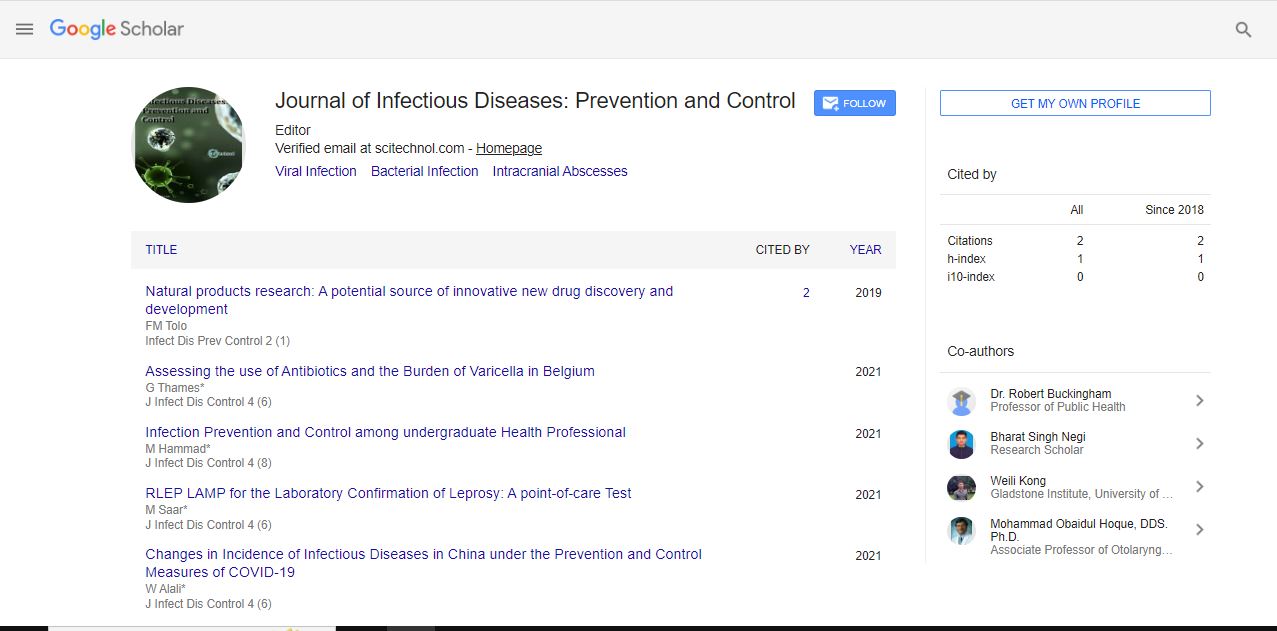Commentary, Vol: 6 Issue: 2
Primary and Secondary Infections: Understanding the Dynamics and Implications
Joon Yim*
1Department of Internal Medicine, Seoul National University College of Medicine, Seoul, Korea
*Corresponding Author: Joon Yim,
Department of Internal Medicine, Seoul
National University College of Medicine, Seoul, Korea
E-mail: yimjj@snu.ac.kr
Received date: 27 May, 2023, Manuscript No. IDPC-23-105453;
Editor assigned date: 29 May, 2023, Pre QC No. IDPC -23-105453(PQ);
Reviewed date: 15 June, 2023, QC No. IDPC -23-105453;
Revised date: 23 June, 2023, Manuscript No. IDPC -23-105453 (R);
Published date: 30 June, 2023, DOI: 10.36648/idpc.5.2.132
Citation: Yim J (2023) Primary and Secondary Infections: Understanding the Dynamics and Implications. Infect Dis Prev Control 6:2.
Abstract
Infectious diseases are caused by various pathogens that can lead to primary and secondary infections. Understanding the mechanisms underlying these infections is crucial for effective prevention, diagnosis, and treatment strategies. This provides an in-depth exploration of primary and secondary infections, elucidating their definitions, etiology, immune responses, and clinical implications. Additionally, we discuss the importance of surveillance, vaccination, and antimicrobial management in mitigating the burden of these infections. By the complexities of primary and secondary infections, we aim to enhance our knowledge and equip healthcare professionals to combat infectious diseases more effectively
Description
Infectious diseases are caused by various pathogens that can lead to primary and secondary infections. Understanding the mechanisms underlying these infections is crucial for effective prevention, diagnosis, and treatment strategies. This provides an in-depth exploration of primary and secondary infections, elucidating their definitions, etiology, immune responses, and clinical implications. Additionally, we discuss the importance of surveillance, vaccination, and antimicrobial management in mitigating the burden of these infections. By the complexities of primary and secondary infections, we aim to enhance our knowledge and equip healthcare professionals to combat infectious diseases more effectively.
Infectious diseases continue to pose significant threats to global health. Pathogens responsible for these diseases can initiate primary infections, which occur when an individual encounters a pathogen for the first time. Primary infections can stimulate an immune response, resulting in the elimination or control of the pathogen. However, under certain circumstances, primary infections can progress into secondary infections, characterized by reinfection or reactivation of a pathogen. This explores the dynamic interplay between primary and secondary infections, clarify on their definitions, causes, immune responses, and clinical implications.
Primary infections are the initial encounters between a host and a specific pathogen. They can be caused by various microorganisms, including bacteria, viruses, fungi, and parasites. The transmission of primary infections can occur through direct contact, respiratory droplets, contaminated surfaces, vectors, or other routes specific to the pathogen. The severity and clinical manifestations of primary infections can vary widely, depending on the pathogen, host factors, and immune response.
Upon encountering a pathogen, the immune system mounts a complex response to eliminate or control the infection. The innate immune response acts as the first line of defence, triggering a rapid but non-specific response. This is followed by the adaptive immune response, which involves the activation of specific immune cells, such as T and B lymphocytes, to produce pathogen-specific antibodies and memory cells. The immune response to primary infections is essential for preventing severe illness, clearing the pathogen, and establishing immunological memory.
Secondary infections occur when a host experiences a subsequent encounter with a pathogen. They can manifest as reinfection by the same pathogen or reactivation of a latent infection. Reinfection can result from waning immunity or exposure to a different strain or variant of the pathogen. Reactivation infections typically arise from dormant pathogens, such as the varicella-zoster virus causing shingles in individuals previously infected with chickenpox.
The immune response to secondary infections may differ from that of primary infections. While some aspects of the adaptive immune response remain similar, memory cells generated during the primary infection play a crucial role in the response to secondary infections. Memory cells allow for a more rapid and targeted immune response, aiming to control the pathogen before it can cause severe illness. However, immune evasion strategies employed by certain pathogens can complicate the immune response and increase the risk of secondary infections.
Secondary infections can present unique challenges compared to primary infections. They may exhibit altered clinical manifestations, be more severe, or involve drug-resistant pathogens. In healthcare settings, secondary infections can occur due to hospital-acquired or healthcare-associated pathogens, posing a considerable burden on patient outcomes and healthcare resources. Early detection, appropriate treatment, and infection prevention measures are vital to mitigate the impact of secondary infections and improve patient outcomes.
Effective surveillance systems, robust vaccination programs, and antimicrobial management efforts are crucial in preventing and managing primary and secondary infections. Surveillance allows for early detection of outbreaks, monitoring of antimicrobial resistance patterns, and informed public health interventions. Vaccination plays a vital role in preventing primary infections and reducing the incidence of secondary infections. Antimicrobial management aims to optimize the use of antimicrobial agents to minimize resistance and prevent secondary infections caused by drug-resistant pathogens.
Primary and secondary infections represent a complex interplay between pathogens, the immune system, and the host. Understanding the mechanisms underlying these infections is essential for effective prevention, diagnosis, and treatment strategies. By investing in surveillance, vaccination, and antimicrobial management, we can reduce the impact of secondary infections and lessen the burden of infectious illnesses. This serves as a comprehensive resource to enhance knowledge and guide healthcare professionals in combating primary and secondary infections effectively.
 Spanish
Spanish  Chinese
Chinese  Russian
Russian  German
German  French
French  Japanese
Japanese  Portuguese
Portuguese  Hindi
Hindi 